#excavation
Text

Young Girl at the Excavations of Pompeii
by Filippo Palizzi
#filippo palizzi#art#excavation#excavations#excavating#history#antiquity#archaeology#europe#european#pompeii#italy#southern italy#girl#maiden#archaeologists#architecture#ancient rome#ancient roman#roman#ruins#fresco#frescoes#painting
856 notes
·
View notes
Text
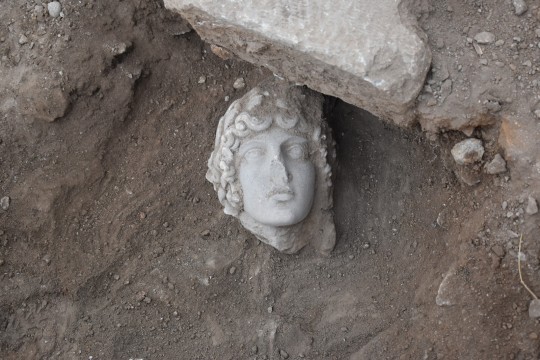

Απόλλων 2ος αιώνας μ.Χ
"Perdidi musam facende , nec me Apollo respicit :
Sic Amyclas, cum tacerent, perdicit silentium. "
Pervirgilium Veneris
[Unknown poet of 2nd-3rd century ad]
54 notes
·
View notes
Text
69 notes
·
View notes
Text

This is the rear of the shield at Canal Street, part of the tunnel ring where sandhogs (as excavation workers are known) are working on the Holland Tunnel, November 25, 1922. When completed five years later, it connected Manhattan to Jersey City.
Photo: Associated Press
#vintage New York#1920s#Holland Tunnel#Nov. 25#25 Nov.#tunnel construction#sandhogs#excavation#vintage NYC
66 notes
·
View notes
Link
KICKING OFF THE HALLOWEEN SEASON WITH A REAL BANG, POLAND
Although also very practical, sickle across the neck. Even if she does wake up, she’s not going anywhere...at least not very far...
668 notes
·
View notes
Photo

Source details and larger version.
26 notes
·
View notes
Photo
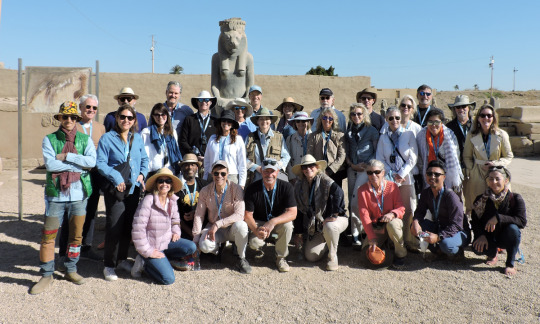
We began work on January 28, but the highlight of this week was the January 31 visit to the site by Anne Pasternak, the Brooklyn Museum Director, and members of the Museum’s Board of Governors. We were thrilled to be able to show them the site where Brooklyn has worked for the past 40+ years. We hope they enjoyed their visit.

As promised last week, here are the members of our team. Our foreman again this year is Abdel Aziz Farouk Sharid (left). He and our inspector, Haitham Mohamed Sa’ad el-Din are discussing the season’s work. The Supreme Council of Antiquities (SCA) assigns an inspector to every expedition to act as liaison with the SCA and help facilitate the work. We are happy to have Haitham with us this season.

Besides Abdel Aziz, the Qufti who working with us this year are Abdel Aziz’s brother Ayman Farouk Sharid (center), the foreman for the Johns Hopkins University expedition who works with us when Hopkins isn’t in the field; and Mamdouh Kamil, who has worked with us for many seasons. All are from the village of Quft (ancient Coptos), which has a long tradition of archaeology going back to the late 19th century. Ayman and Abdel Aziz are the sons of one of the great Egyptian archaeologists, the late Farouk Sharid Mohamed, who was a beloved friend and treasured colleague. His sons are worthy successors to him.

You are looking northwest at the first court of Temple A, which stands northeast of the Mut Temple. We are working in two areas of the court this year. In 2019 we were able to confirm that that the row of limestone features on the court’s south side were sphinx bases. This season we want to see if there are remains of corresponding bases on the north side (right). We are also clearing the corridor between the south colonnade and the south wall of the court (left).

By the end of the week (February 2) the results in the north square were equivocal. Looking north, you can see an area of decayed limestone on the right side of the square that might be the remains of a sphinx base. On February 1, Mamdouh uncovered the round, dark feature to the left of the “sphinx base” that might be a tree hole. Sphinx avenues often had trees planted between the sculptures.

The work on the corridor was more productive. By the middle of the week Ayman had cleared a mass of broken stone and revealed the lowest course of the court’s south wall (left) and the footing of the temple’s 2nd Pylon. Both sit on a sand foundation that you can see below the blocks of stone. It was common to use sand in the foundations to level out uneven ground.

On February 1 our Dutch colleague, Jacobus (Jaap) van Dijk joined us for another season. First thing on the morning of February 2, Ayman called us over to show us an interesting find: a large relief-decorated block. Jaap immediately got down to have a look.

The block has a beautifully carved relief of Amun that clearly is Thutmoside in style, that is, from the reign of Hatshepsut and/or Thutmosis III, of the mid-15th century BC. What makes it particularly interesting is the small, shallowly carved graffito of a God’s Wife of Amun facing the Amun and dating stylistically to Dynasty 25 or 26, about 700 years after the god’s face was carved. God’s Wives of Amun were priestesses, usually the sisters or daughters of kings, who wielded great political power in the Third Intermediate Period and later.
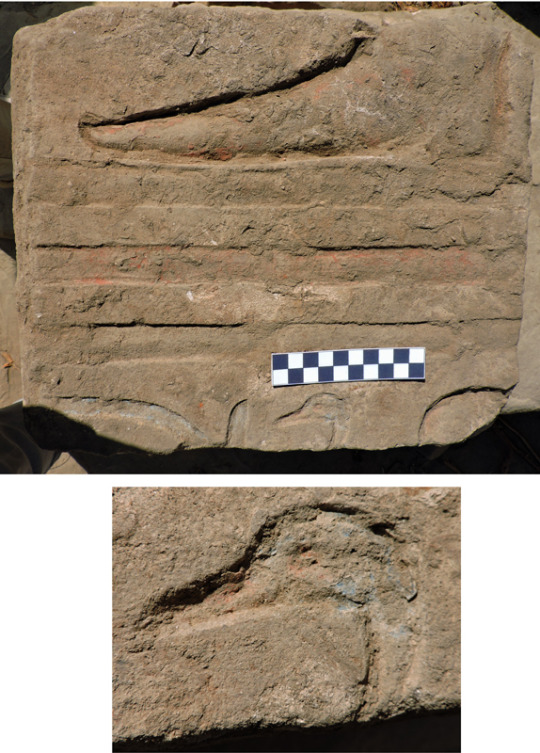
Just west of the Amun block was smaller cube of stone with a sunk relief depiction of a man’s foot on base lines with the top of a cartouche and the “son of Re” title below. The style of the foot (very long) and the vertical element of the cartouche date it to the reign of Akhenaten. It probably came originally from his temple in East Karnak, built before the king moved the capital to Amarna. The artist paid attention to detail when painting the relief, painting the head of the goose (“son”) blue but its beak and eye red. The Brooklyn Museum has an interesting group of Amarna Period reliefs showing a pastoral scene.

By the end of the week Ayman and his crew had cleared the bases of the first 3 columns of the colonnade, working from west to east. The blocks of the bases are large: 70 cm by 125 cm and almost 100 cm thick.
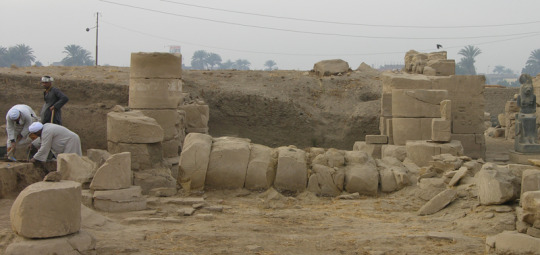
We are also planning on restoring 2 fallen columns in the colonnaded porches in front of the Mut Temple. The one in the East Porch is shown here as it was found in 1979. Work hasn’t started on these yet; there will be more about the restoration next week.
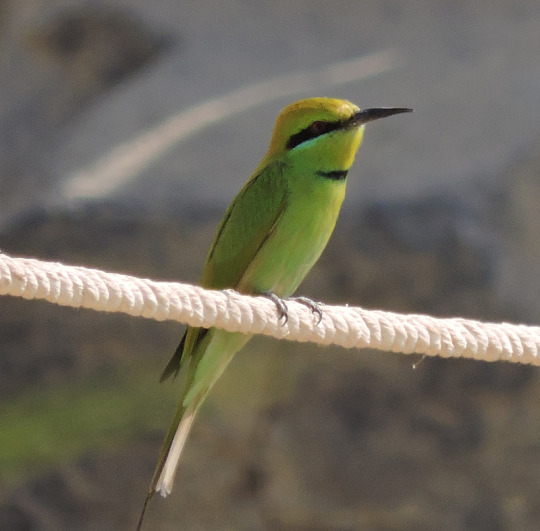
One of our favorite birds is the tiny, bright bee eater, so called because it catches insects in mid-air. This is the first we’ve seen this season.

An unusual cloud formation seen at sunset one night. Angels? Extraterrestrials?
Posted by Richard Fazzini and Mary McKercher
#BkMMutDig#MutDig#Mut#temple#Egypt#excavation#BkMEgyptianArt#egyptian art#egyptian#amarna period#Akhenaten#Thutmoside#archaeology#Brooklyn Museum#brooklyn#museum#art
223 notes
·
View notes
Text
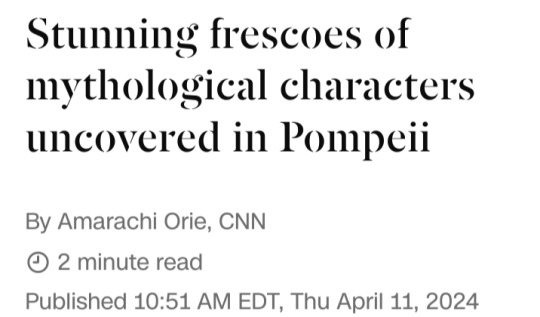


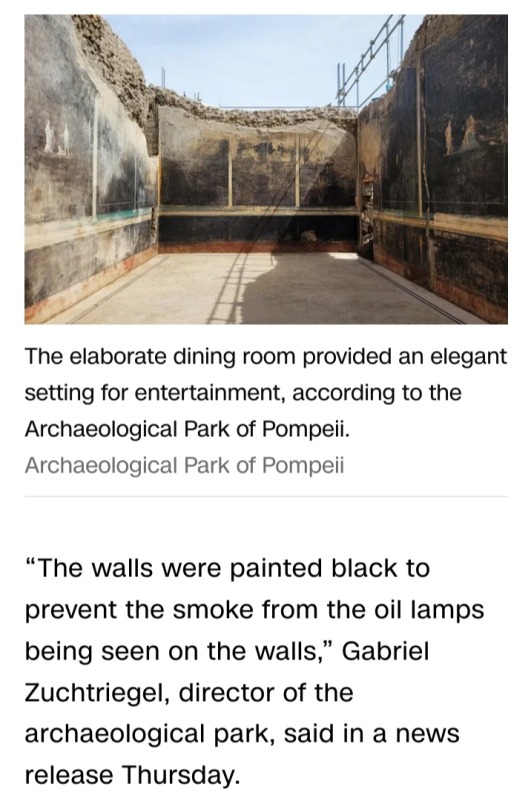






#Pompeii#Ancient Romans#frescoes#Apollo#Cassandra#King Priam of Troy#banquet halls#Archaeological Park of Pompeii#Helen#Paris#Menelaus#Trojan War#Mount Vesuvius#79 CE#excavation#archaeology
20 notes
·
View notes
Text
In 1997, a crypt of skeletons was unearthed during an excavation of Stirling Castle in Scotland. What was originally believed to have been part of the Governor’s Kitchens was revealed to be the ‘lost’ private chapel believed to have been built in the early 1100s.
16 notes
·
View notes
Text
Dear early archaeologists,
Human remains are not your property. I am fully aware that the governments under which you attained the excavation material did not exercise their right to stop you from removing said remains.
However, any desecration of the individual’s remains, (such as some who have permanently arranged them in a manner for display like pouring resin over the remains, retained their bones for purposes other than scientific analysis, or any purposeful ignorance of the direct wishes of their modern ancestors) is proof of not only your unnecessary abandonment of the personhood of these ancient peoples, your disregard for those who are simply unlike you in any manner, and, finally, your carelessness for their culture in which you seem to have forgotten you have dedicated your time and likely quite a lot of your own money to.
Human remains as well as the material culture of these people is not yours to deserve, obtain, or hoard.
I understand that what you did was legal. In your eyes, it may have even been the most moral thing to do to preserve a person’s memory. However, there is no excuse to permit such irreversible behavior. Archaeology is a destructive science. You must understand that your worldview is not the collective goal of the world.
Remember the humanity of those from whom you seek to learn.
#dear early archaeologists#archaeology#history#writing letters#morality#letters to dead people#life as a modern archaeologist#we have to deal with this crap#excavation#ethics#respect the dead#human remains
130 notes
·
View notes
Text
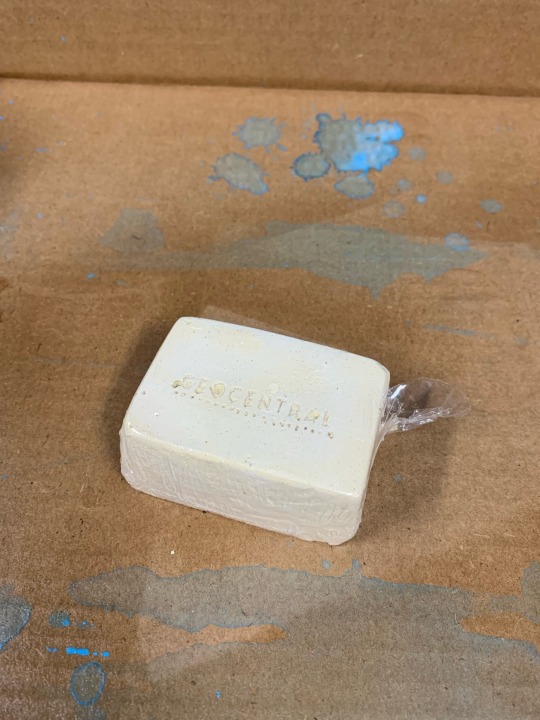



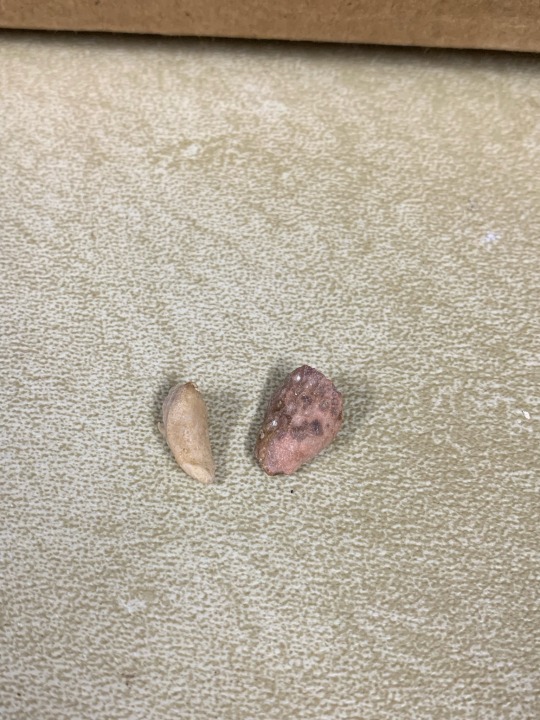
I did a fossil excavation from a kit I got.
The fossil on the left is a shark tooth. However, I don’t know what the fossil on the right is.
@a-dinosaur-a-day
21 notes
·
View notes
Text
A 3,800-year-old Akkadian cuneiform tablet was found during the archaeological excavations carried out in the Aççana Mound, the old city of Alalakh, in the Reyhanlı district of Hatay city in southern Turkey.
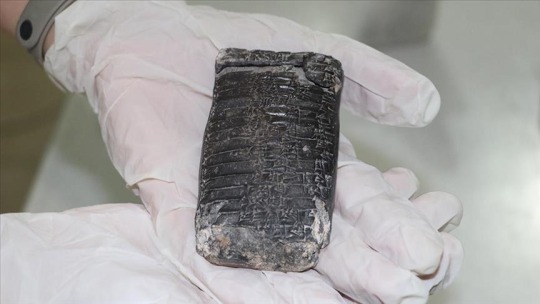

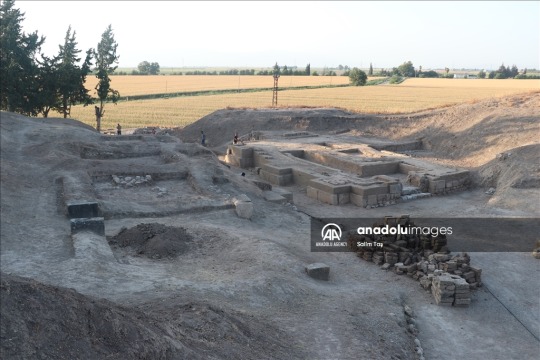
Removing the wall rubble as part of the study, the team found a cuneiform clay tablet among the remains.
In the first examination of the Akkadian tablet, information regarding the agreement made by Yarim-Lim, the first known king of Alalakh, to buy another city was found.
Akar emphasized that the tablet found among the remains, dating back 3,800 years, is in a well-preserved form. "While removing the debris of a few collapsed walls at the mound, it was very exciting to come across a tablet that had never been touched or damaged," he said.
Akar continued by stating that the historical period of the artifact extends to the Middle Bronze Age. "During the Middle Bronze Age, a period we define as such, we observe that the kings of this region possessed economic power. This is evidenced by astonishing examples documented in written records. In this tablet, we see that Yarim-Lim, the first known king of Alalakh, intended to purchase another city and, in this regard, entered into an agreement. This actually demonstrates that the kings in this region had the economic capability and potential to acquire another city," he said.
Assoc. Prof. Dr. Akar, who pointed out that the tablet would also contribute to understanding the economic structure of the era, stated,
"The tablet likely contains the names of significant individuals from the city who witnessed this sale. In a sense, we see evidence of a witness list from that period,"
"The work came out as an extremely unique example, especially to decipher the economic structure of that period, the relationship between cities, and the economic and political model," he said.
47 notes
·
View notes
Text

cobra-444 - Still in love after death
13 notes
·
View notes
Text
They just discovered the remains of Theatre of Nero so I guess it's time to visit Rome again! How many tickets should I book?
#ancient rome#theatre of nero#archeology#latin#roman empire#nero#caesars#excavation#rome#also#to stop certain comments#it excites me as a prospective archaeologists and antiquity researcher not a tourist
32 notes
·
View notes
Photo
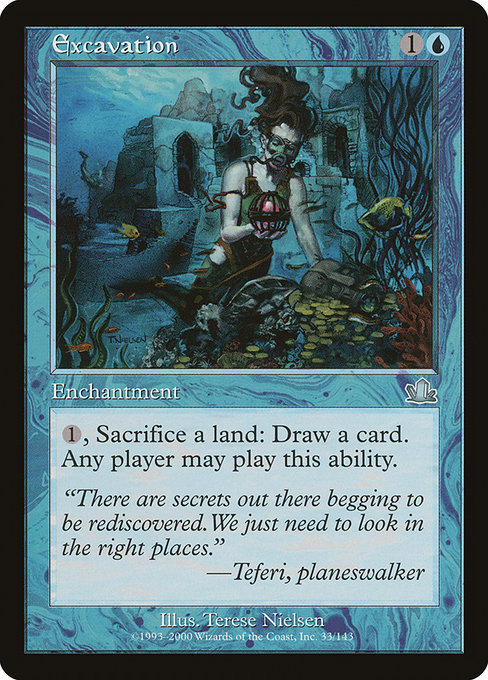
Excavation
"There are secrets out there begging to be rediscovered. We just need to look in the right places." —Teferi, planeswalker
Artist: Terese Nielsen
TCG Player Link
Scryfall Link
EDHREC Link
23 notes
·
View notes
Photo

Imagine waking up to this view every morning. This picture was taken at sunrise on February 15. The view of the Theban cliffs never gets old.
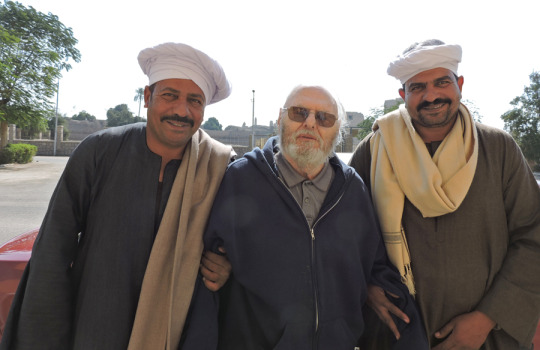
This is something of a bittersweet post. This is our last season in the field, which means we must say goodbye to Ayman and Abdel Aziz. We have known them since they were children and have worked with them as adults for many years. We treasure them and their friendship greatly and regret that we will likely never see them again. Partings are hard.

We had to cut this season short because of health problems, but we managed to accomplish what we set out to do. This photo from the precinct’s enclosure wall shows Temple A’s First Court with the north square with its sphinx bases in the foreground and the colonnade along the south side of the court in the rear
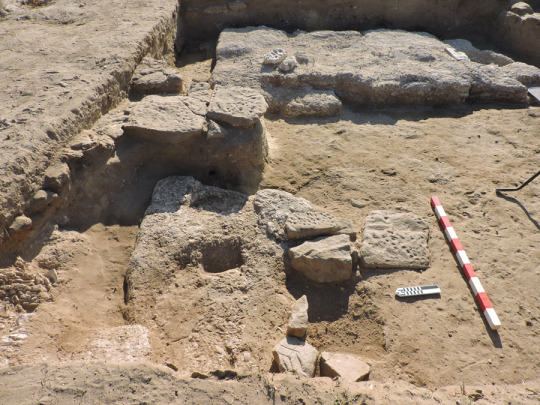
We now have not one but two sphinx bases. You are looking east across what is left of the second base in the northwest corner of the square. Only the northern part of the base remains; the rest is completely gone. The better-preserved base is in the background. The discovery of this second base is even more confirmation that there was once a row of sphinxes on the north side of the court as on the south.

Something of a surprise was the discovery of part of the original paving along the north and east sides of the larger base. It took Mamdouh great patience and skill to bring this paving to light.

Ayman went as far as he could in the corridor on the south side of the court. In addition to the usual broken stone, it is clear that the south wall of the court collapsed at this point, with large blocks now completely blocking the corridor

This view of the corridor, looking east, was taken on February 14, our second last day at the site. The columns and their massive limestone and sandstone foundations are now clear, although we did not find any trace of the corridor’s original flooring, which had been removed in antiquity.

Unlike sandstone, which can decay into sand but is otherwise pretty stable, limestone has a tendency to fracture. When we removed the beautiful limestone block with the head of Amun and the God’s Wife of Amun, it broke to pieces. An Egyptian conservator is painstakingly putting it back together (the block is upside down). He hadn’t finished by the time we left, but Abdel Aziz has promised a photo of the finished restoration that we can show in the next post
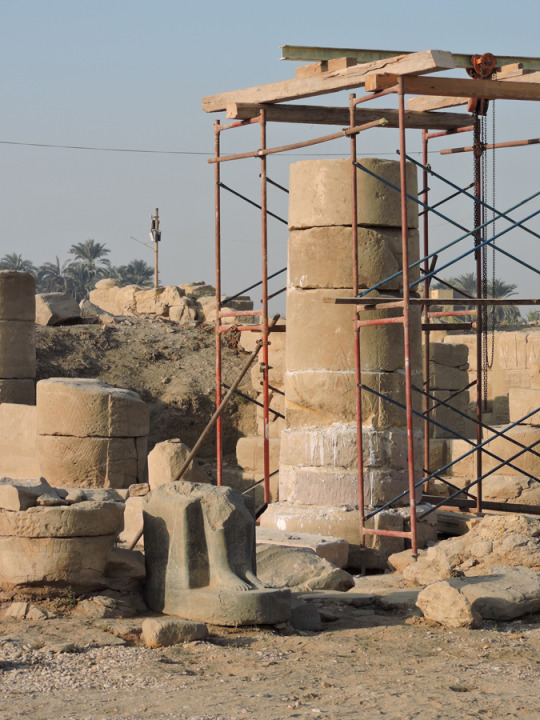
This is the east, better-preserved side of the column in the East Porch at the end of the season.

The other side of the column was much more damaged, so the restorers have been filling in the missing portions with a cement mixture. The man on the scaffold is roughing up the surface so that the finishing coat can be applied. Once that’s done, all the drips will be cleaned up.

The second column to be restored this season was found when we cleared the Mut Temple’s West Porch in 2005. We haven’t talked about it yet as it is a more complicated project that couldn’t begin until the repairs to the east column were well underway. As you can see, it, too, collapsed to the west, but what remained standing has been seriously damaged by flooding, which causes sandstone to decay. The top block has turned mostly to sand, and the column base is very decayed as well.
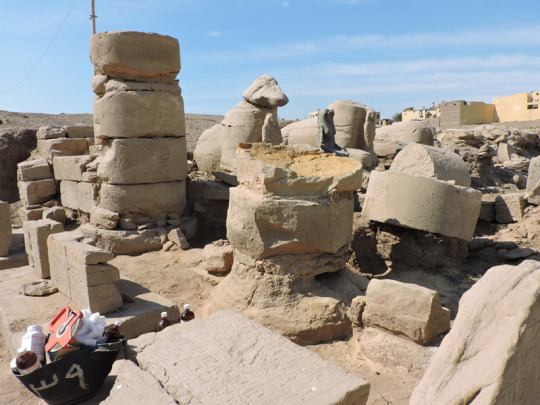
By the start of this season, little was left of the upper block, so the restorers’ first task was to clean up the base and remove the sand from the upper block so that what is left could be consolidated. This photo shows the state of the column on February 4.
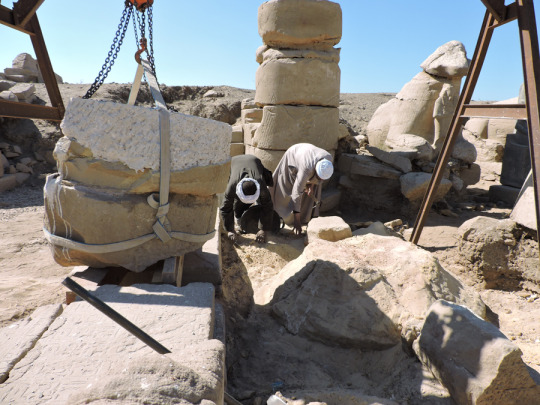
The next step was to build a form to fill in the missing part of the upper block to a uniform height. Then both column drums were moved onto a temporary platform so the base could be cleaned. It, too, had largely turned to sand, so Mamdouh went to work to clear the sand down to solid stone.
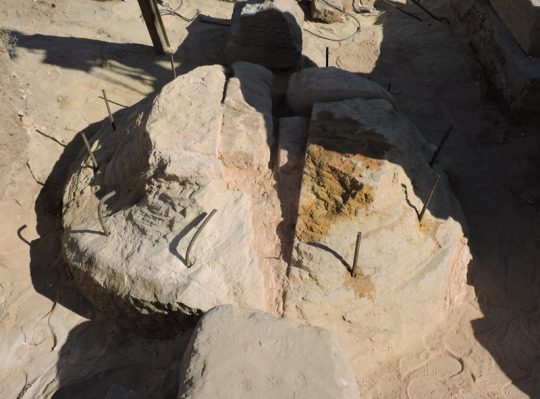
This is the condition of the column base on February 15, our last day at the site. Interestingly it is made up of several small blocks rather than the usual pair of semi-circular blocks. The metal bars will reinforce the fill that will bring the base up to a proper level.
Work on both columns will go on after we have gone. When the repairs are complete, Abdel Aziz will send us photos that we will post to show the result of their efforts. The work is expected to take another 10 days, so there will be something of a gap between this post and the final one of the season.

On Sunday Mary spotted this painted lady butterfly near where we are working, the first we’ve ever seen at Mut. Only a few inches across, this small creature migrates across the Sahara Desert every year. Amazing! We thank our niece, naturalist Rosemary Mosco, for identifying it for us.
Posted by Richard Fazzini and Mary McKercher
#BkMMutDig#MutDig#Brooklyn Museum#art#excavation#Egypt#temple#BkMEgyptianArt#archaeology#brooklyn#museum#sahara desert#amun#column#limestone
88 notes
·
View notes